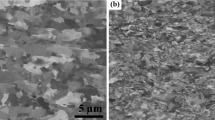Abstract
The present study describes the methods for the characterization of the microstructure of welded joints from test welds. This comprises the analysis of the solidification microstructure (primary and secondary dendrite arm spacing) as well as the former austenite grain size and the final phase distribution. The main focus is the characterization of nonmetallic inclusions by means of SEM/EDX and light microscopy. Based on already-developed prototypes with a weld yield strength of more than 800 MPa, different kinds of inclusions and precipitates have been assessed with respect to grain refinement and the resulting impact on strength and ductility. The effect of aluminum, in the range 90 to 800 ppm, on the microstructure and the mechanical properties of high-strength steel weld metals has been studied and it has been found that at low aluminum contents good values for the tensile strength and the toughness could be obtained. The results of metallographic investigations of test welds with different alloy compositions are presented. The results indicate a significant change of the size distribution, the morphology, and the composition of the inclusions. These results are finally compared with results from literature and discussed with respect to the expected influence on the mechanical properties of the welded joint.















Similar content being viewed by others
References
Belyakov A, Sakai Y, Hara T, Kimura Y, Tsuzaki K (2001) Thermal stability of ultra fine-grained steel containing dispersed oxides. Scr Mater 45(10):1213–1219
Takaki S, Kawasaki K, Kimura Y (2001) Mechanical properties of ultra fine grained steels. J Mater Process Technol 117(3):359–363
Caballero FG, Bhadeshia HKDH, Mawella KJA, Jones DG, Brown P (2002) Very strong low temperature bainite. Mater Sci Technol 18(3):279–284
Ouchi C (2001) Development of steel plates by intensive use of TMCP and direct quenching processes. ISIJ Int 41(6):542–553
Ali A, Bhadeshia HKDH (1991) Microstructure of high strength steel refined with intragranularly nucleated Widmanstätten ferrite. Mater Sci Technol 7(10):895–903
Grong Ø (1997) Metallurgical modelling of welding, 2nd edn. The Institute of Materials, Minerals and Mining, Cambridge
Frederikson H (1976) The mechanism of the peritectic reaction in iron-base alloys. Mater Sci Technol 10(3):77–86
Frederikson H, Stjerndahl J (1982) Solidification of iron-base alloys. Mater Sci Technol 10(12):575–585
Babu SS 1991 Acicular ferrite and bainite in Fe-Cr-C weld deposits. Ph.D. Thesis, University of Cambridge
Babu SS, David SA (2002) Inclusion formation and microstructure evolution in low alloy steel welds. ISIJ Int 42(12):1344–1353
Pottore NS, Garcia CI, Hiejlen J (1991) Interrupted and isothermal solidification studies of low and medium carbon steels. Metall Mater Trans A 22(8):1871–1880
Widgery DJ 1974 Deoxidation practice and the toughness of mild steel weld metal. Ph.D. Thesis, University of Cambridge
Sugden AAB, Bhadeishia HKDK (1988) The nonuniform distribution of inclusions in low-alloy steel weld deposits. Metall Mater Trans A 19(3):669–674
Kluken AO, Grong Ø, Hjielen J (1991) The origin of transformation textures in steel weld metals containing acicular ferrite. Metall Mater Trans A 22(3):657–663
Bhadeshia HKDH (2001) Bainite in steels, 2nd edn. The Institute of Materials, Minerals and Mining, Cambridge
Dantzig JA, Rappaz M (2009) Solidification, 1st edn. EPLF Press, Lausanne
Kiviö M, Holappa L, Iung T (2010) Addition of dispersoid titanium oxide inclusions in steel and their influence on grain refinement. Metall Mater Trans B 41(6):1194–1204
Kikuchi N, Nabeshima S, Kishimoto Y, Matsushita T, Sridhar S (2002) Effect of Ti de-oxidation on solidification and post-solidification microstructure in low carbon high manganese steel. ISIJ Int 47(9):1255–1264
Evans GM (1993) Microstructure and properties of ferritic steel welds containing Al and Ti. IIW Doc. II-A-901-93
Ovtchinnikov S 2002 Kontrollierte Erstarrung und Einschlussbildung bei der Desoxidation von hochreinen Stahlschmelzen (Controlled solidification and inclusion formation during deoxidation of high purity steel melts). Ph.D. Thesis, University of Freiberg (in German)
Plöckinger E, Straube H 1964 Die Desoxidation, Die physikalische Chemie der Eisen und Stahlerzeugung (The deoxidation, the physical chemistry of iron and steel production). Verlag Stahleisen, Düsseldorf pp. 303–349. (in German)
Javoiskij VI 1969 Theorie der Stahlerzeugung (Theory of steel production). Deutscher Verlag für Grundstoffindustrie, Leipzig (in German)
Kurz W, Fisher DJ (1998) Fundamentals of solidification, 4th edn. Trans Tech Publications Ltd, Zürich
Glicksman ME, Voorhees PW (1984) Ostwald ripening and relaxation in dendritic structures. Metall Mater Trans A 15(6):995–1001
Keehan E (2004) Effect of microstucture mechanical properties of high strength steel weld metals. Ph.D. Thesis, Göteborg University
Svensson LE (1994) Control of microstructure and properties in steel arc welds. CRC Press, Inc
Bhadeshia HKDH, Svensson LE, Gretoft B (1986) The austenite grain structure of low-alloy steel weld deposits. J Mater Sci 21(11):3947–3951
Quintina MA, McLaine J, Babu SS, and David SA (2001) Inclusion formation in self-shielded flux cored arc welds. Welding Research Supplement pp. 98–105
Cabrera-Marrero JM, Carreño-Galindo V, Morales RD, Chávez-Alcalá F (1998) Macro–micro modeling of the dentritic microstructure of steel billets processed by continuous casting. ISIJ Int 38(8):812–821
Miettinen J (1992) Mathematical simulation of interdendritic solidification of low-alloyed and stainless steels. Metall Mater Trans A 23(4):1155–1170
Acknowledgments
The investigations presented were supported by the Böhler Schweißtechnik Austria GmbH, the Voestalpine AG and the Austrian Research Promotion Agency (FFG). Special thanks are given to all the industry partners and project partners for the support.
Author information
Authors and Affiliations
Corresponding author
Additional information
Doc. IIW-2269, recommended for publication by Commission II “Arc Welding and Filler Metals”.
Rights and permissions
About this article
Cite this article
Vanovsek, W., Bernhard, C., Fiedler, M. et al. Influence of aluminum content on the characterization of microstructure and inclusions in high-strength steel welds. Weld World 57, 73–83 (2013). https://doi.org/10.1007/s40194-012-0008-0
Received:
Accepted:
Published:
Issue Date:
DOI: https://doi.org/10.1007/s40194-012-0008-0




